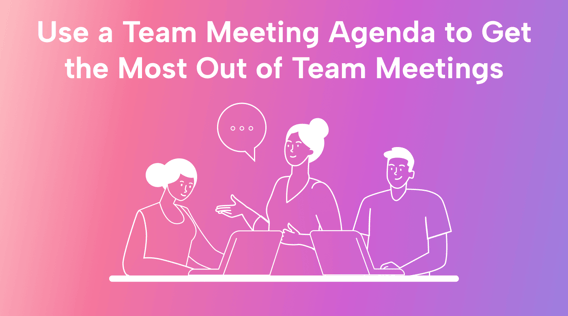Did you know that 50% of all meetings are a waste of time? On average, each worker dedicates 31 hours to unproductive meetings in a single month.
A few other notable stats include:
- 91% of employees are distracted during meetings
- 73% are doing other work
- 39% are nodding off
- 45% are grumbling about the amount of meetings they have to attend
But meetings shouldn’t be where productivity goes to die. Meetings should be the place where real work gets done.
No matter what the setting, anyone can acquire the skills to lead effective and successful meetings. The key is to plan and write an agenda. Seems obvious, we know! But it’s the missing step for many teams who are wasting their time winging it and making up the agenda as they go along. Creating a team meeting agenda needn’t be a huge task, but spending a little time here can save you tons of time moving forward.
An agenda for a team meeting is an ordered set of topics and action items that must be addressed and discussed with the team during the meeting. The idea is to stay organized, on-topic, and efficient.
Creating an agenda for a team meeting requires more than just writing down a list of discussion topics with a timeline—pulling off productive meetings takes a bit of thinking and effort.
This article will explore a few ideas and guidelines for constructing a detailed agenda for your next meeting, be it a weekly team meeting or an all-hands meeting. Keep reading until the end, where we provide you with team meeting agenda templates for the most common types of team meetings.
Types of meetings
There really are only three reasons to meet: to impart something (informative), gather information (or feedback), or collaborate through a specific problem.
And there are essentially two styles of leadership: authoritarian and servant leadership. Authoritarians lead as the sole decision-makers. Servant leaders, on the other hand, are team guides that help push their teams to self-sufficiency.
Mix 'em up, and you get these regular meetings, each with its own purpose and approach:
- Staff meetings are a chance for your team to examine various meeting topics around the business. (informative—best for authoritarian leader)
- Project kickoff meetings are used to jumpstart new projects and usually include project goals, work products, and deadlines. (informative—best for authoritarian leader)
- Brainstorming meetings are where you and your entire team come together to flesh out a new idea with fresh perspectives and a supportive environment. (collaborative meeting— best for servant leadership)
- Feedback meetings are for soliciting opinions from the entire team. (feedback—best for servant leadership)
- Retrospective meetings are conducted after the completion of a project to analyze what went well and what didn't. (feedback meeting—best for servant leadership)
- Sprint planning meetings are for the detailed planning of an upcoming sprint. (collaborative—best for servant leaders)
- Sprint reviews are an opportunity for Agile teams to present their work from a sprint to clients and stakeholders, get sign-off, and gather feedback. (feedback—best for servant leaders)
- Product backlog grooming meetings are used for prioritizing and managing the product backlog. (collaborative—best for servant leaders)
- Committee meetings are subgroup that help accomplish specific tasks with broad implications. (collaborative meeting—best for authoritative)
What do all good team meeting agendas contain?
A team meeting agenda can be quite flexible; however, certain elements are fundamental for running a successful meeting. An effective meeting agenda should always include these essential components:
Date, time, and location
These details are especially important for dispersed teams. Take note of the locations of all remote team members and make sure to include the time zone.
Objective and goals
Without a meeting objective or meeting goal, you might lose track of what's important or convey the wrong message to your team about the meeting.
Ask yourself, “How does this meeting fit in? What do I hope to achieve?”
Facilitator and attendees
While it isn't essential to record attendance, with a record of who is in charge (meeting organizer), the team members will know whom to inform if they can't attend the meeting or have something to contribute to the agenda.
Agenda items
The agenda items should be a succinct list of topics, and the desired outcome of each topic. Be concise and speak in plain language to make the outcome obvious to all.
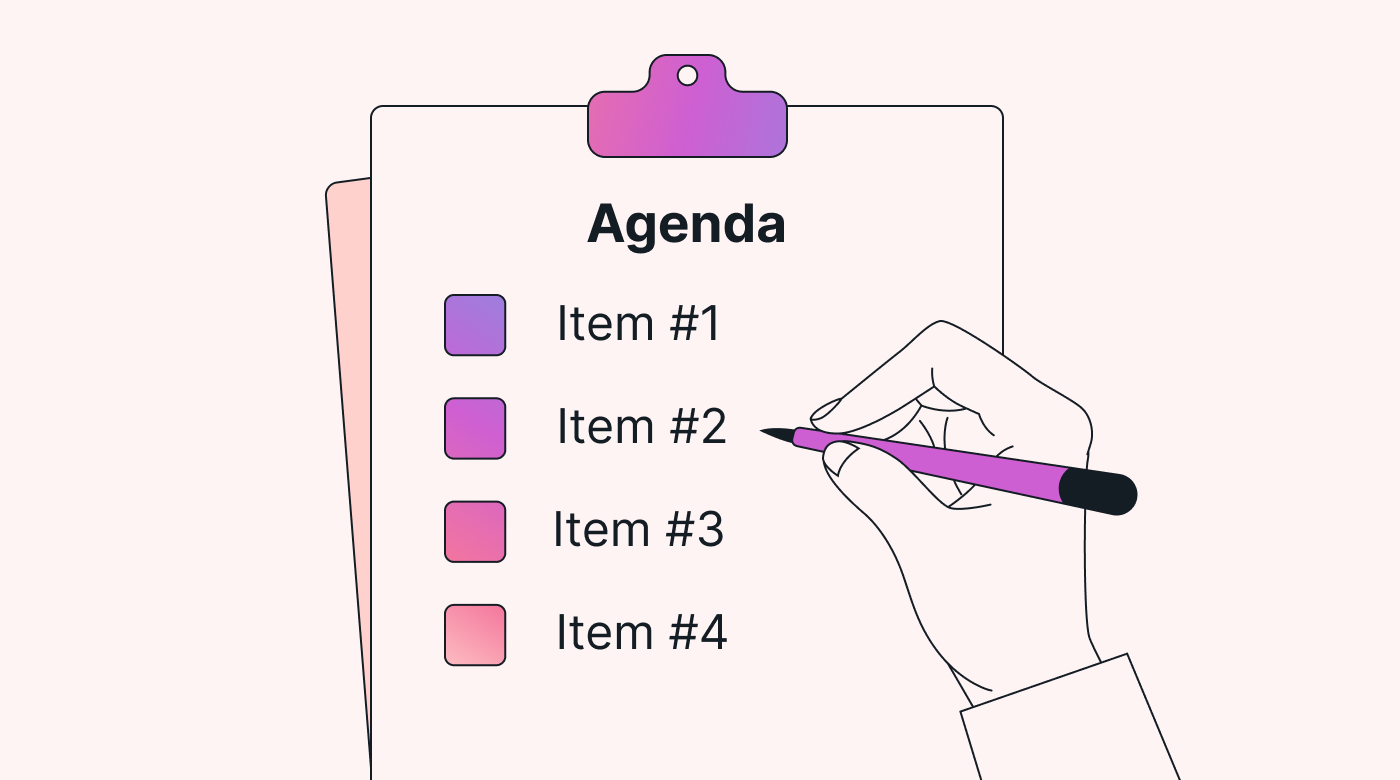 |
Time for each topic
It helps to note a predicted time frame for every agenda item to keep your meeting organized and running on time.
3 (useable) team meeting agenda templates
There are many ways to structure your meeting agenda, but laying out your points hierarchically will make the most logical sense. So does adding the key details like date, attendees, and objective at the top.
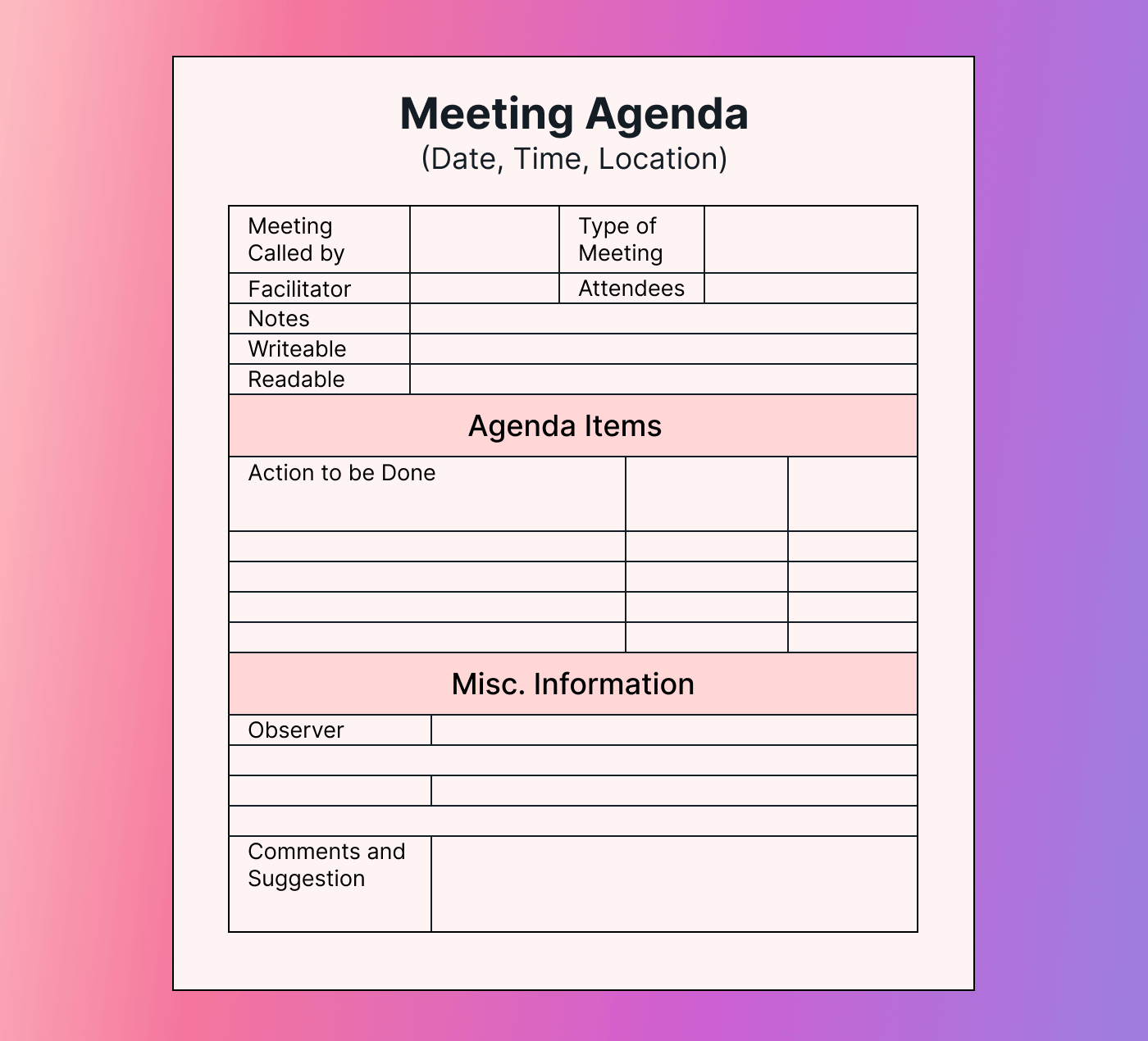 |
The last thing you want is people scratching their heads trying to figure out the agenda for a meeting. To help you, we've put together three meeting agenda templates below. Feel free to copy and paste.
General staff meeting agenda template (informative)
Agenda for the (company name) employee meeting
Date:
Time:
Facilitator: (list the lead facilitator)
Attendees: (mention all the attendees)
(List the names of attendees)
Opening (5 minutes)
- A quick summary of the meeting's purpose
Team check-in (10 minutes)
- Pleasant icebreaker
- Or a speedy round-robin
Agenda Items:
- Item 1: (add title) X mins
- (a brief description of item 1)
- (list task or question)
- Item 2: (add title) X mins
- (a brief description of item 2)
- (list task or question)
- Item 3: (add title) X mins
- (a brief description of item 3)
- (list task or question)
- Item 4: (add title) X mins
- (a brief description of item 4)
- (list task or question)
- Item 5: (add title) X mins
- (a brief description of item 5)
- (list task or question)
Wrap up and take away (5 mins)
Summarize any meeting notes or important findings and assign and document any action items
Brainstorming team meeting (collaborative)
Date:
Time:
Location:
Objective and goals:
Mention the specific challenge or opportunity
Facilitator: (name of the facilitator)
Attendees: (mention all the attendees)
Team Check-In (10 mins)
Agenda:
Introduction to the challenge or opportunity (5 mins)
Clarify the problem or goal and give background information
Guidelines for brainstorming session (5 mins)
Mention the guidelines for the session, for example; open-mindedness, quantity over quality or welcoming wild ideas
Group idea sharing (10 to 30 mins)
Each team member shares their ideas
Idea clustering and refinement (5 mins)
Group similar ideas together
Discuss and refine selected groups until 2 to 3 choices are left
Voting (5 mins)
Team members vote on the most promising ideas
Discuss the top choice and assign action items (10 mins)
Go into deeper details about top choice
Identify next steps, assign responsibilities, and set a timeline
Retrospective meeting agenda (feedback)
Project name:
Date:
Time:
Facilitator:
Attendees:
Action items from the previous meeting:
- Action item A
- Action item B
- Action item C
Retrospective agenda items:
- What went well (10 to 20 min)
- (A brief description of the overall achievements and success—as seen by the managers)
- Team members to each discuss the achievement of the project and give their input
- What didn’t (10 to 20 min)
- (A brief description of the overall challenges and obstacles—as seen by the managers)
- Team members to each discuss the challenges of the project and to give their input
- What can we improve next time (20 min)
- Discuss the lessons learned in this project as a group
- Action items (5 min)
- Go over the action items to take away from the meeting and assign duties
Best practices for effective team meeting agendas
Now that you have successfully created a meeting agenda, it's time to put it into practice. Here are 6 tips to make the most of the meeting.
Send out your agenda ahead of time
Send out the meeting agenda to attendees as soon as possible.
An agenda with strategic questions should be sent to participants no later than a week prior to the meeting. For most other questions, a three-day lead time should suffice.
A project management system can be helpful here—you can store the agenda in it and have it available to everyone who is attending the meeting.
You can also encourage attendees to take notes in the electronic version of the agenda and making those collaborative meeting minutes.
Seek feedback
Talk about collaboration, once you distribute the agenda, ask for feedback (before the meeting).
There are several benefits to this:
- Gathering feedback guarantees that you will pick topics that pertain to the entire team.
- It gives everyone in the group the opportunity to contribute their perspectives and suggestions.
- Seeking the opinion of participants is an excellent way to empower your team (read: a great culture hack)
List agenda topics as questions or tasks
Articulate the agenda explicitly – and provide questions or tasks that help define the scope of the discussion.
For example, if you have something to share with your team regarding the projected sales goals for the upcoming quarter, clarify what type of feedback you are looking for.
Go conservative
One common mistake is packing your meeting agenda with too many items.
If you want the meeting to be beneficial (and not hurried) then go conservative with your list of topics.
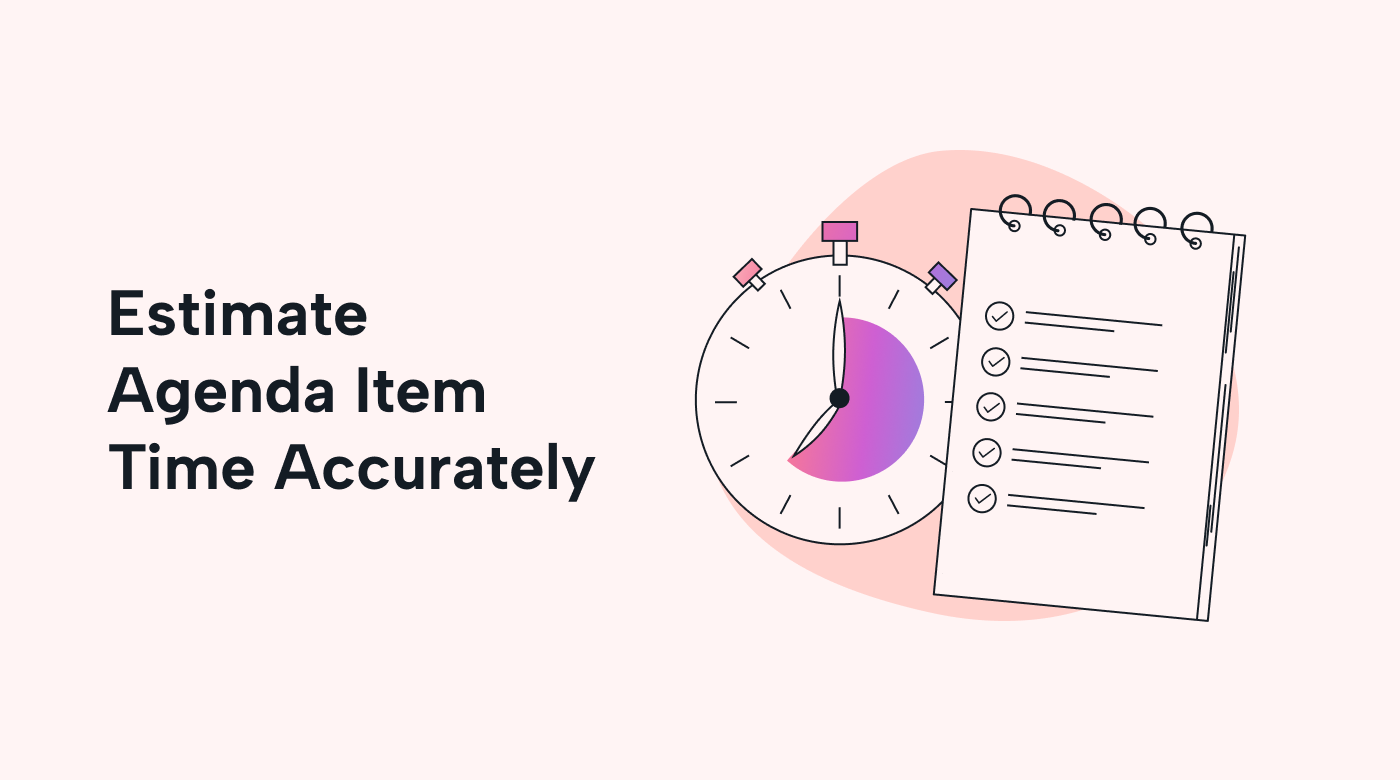 |
Most importantly, stick to the time(s) that you have set out to keep your meetings on track. Not one person on planet earth likes to while away their time in meetings.
Send out your notes, tasks, and assignments after the meeting
Three of the most valuable things to come out meetings will be: meeting minutes, key takeaways and follow-up items (in the form of tasks and assignments).
Obviously the notes and action items will be different depending on the type of meeting.
No matter what, send these out ASAP after the meeting.
Ask for feedback
Finally, just like with events like industry conferences, once in a while ask meeting attendees for feedback after meetings with questions like:
- Did the right people come to the meeting? If not, who should we add to the invite list?
- Was the goal clear?
- Did we pick the right topics for the agenda?
- Did we get the agenda out early enough for people to get ready?
- Did we guess right about how long each topic would take?
- Did the process for talking about each topic work well?
- Was it easy for you to join in the conversation?
- Are we having this meeting at the right time?
Gathering input from others will help you organize more successful meetings in the future. Even better, getting feedback outside of the meeting can empower less outspoken people to share their thoughts.
Use Motion to lock in and manage your team meetings
Scheduling meetings across a busy team can take hours to coordinate and organize. But it doesn’t have to, thanks to Motion.
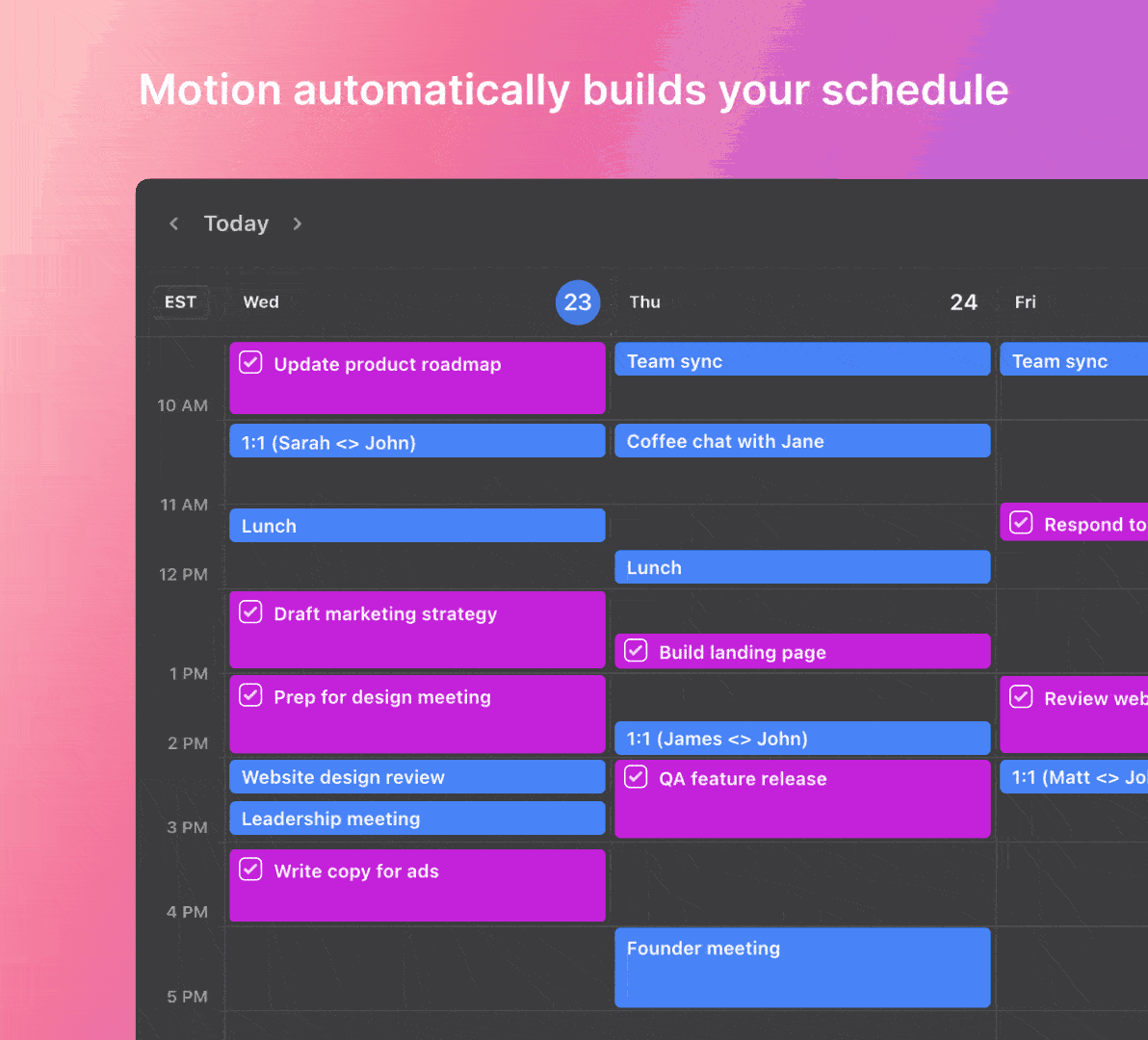 |
Motion is a project management tool with an AI meeting assistant that can automatically find the ideal meeting times for you and your team.
The platform integrates with your team's calendars (Google Calendar, Microsoft Outlook, or Apple calendar) and locks in the perfect meeting time for everyone involved.
Another nifty meeting management feature from Motion is that it can double as a task manager to ensure follow-through on the action items or next steps. It also uses AI to help you automate the assignment of tasks to team members. All you have to do is create the tasks and list the details plus priority, and Motion will find the best time within each relevant team member's schedule to assign them the action items.
Sign up for your 7-day free trial.

